Accounting Concepts and Measurement in Financial Accounting
VerifiedAdded on 2023/03/31
|11
|3095
|291
AI Summary
This assignment provides an overview of accounting concepts and measurement in financial accounting. It discusses the various accounting concepts such as business entity concept, dual aspect concept, money measurement concept, going concern concept, accounting period concept, accounting cost concept, dual aspect concept, realisation concept, accrual concept, and matching concept. It also explores the conceptual framework and issues related to measurement in accounting. Additionally, it covers the fundamental qualitative characteristics of financial information and how to improve quality characteristics. The assignment focuses on Breville group limited, an Australian company dealing in small electrical appliances, and its accounting practices.
Contribute Materials
Your contribution can guide someone’s learning journey. Share your
documents today.
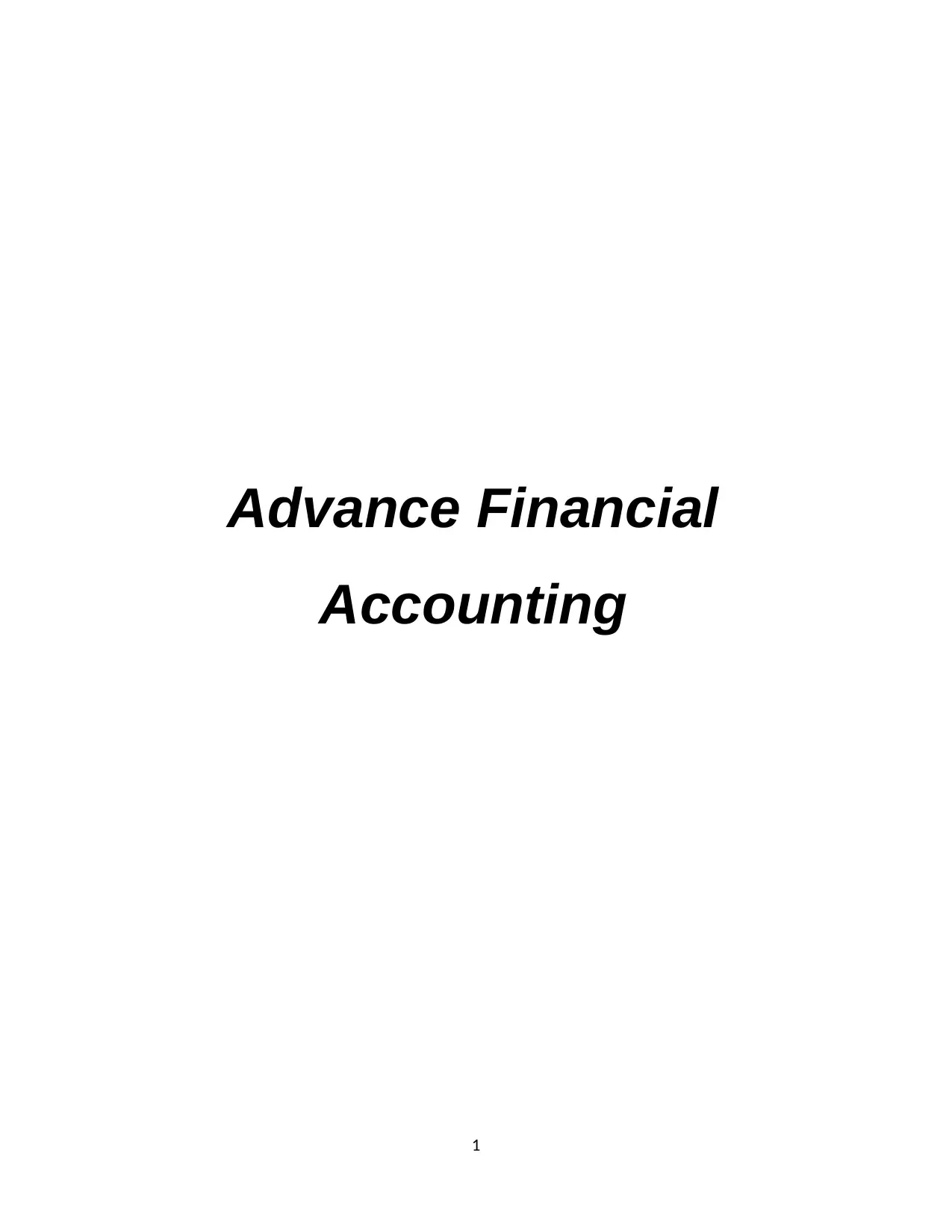
Advance Financial
Accounting
1
Accounting
1
Secure Best Marks with AI Grader
Need help grading? Try our AI Grader for instant feedback on your assignments.
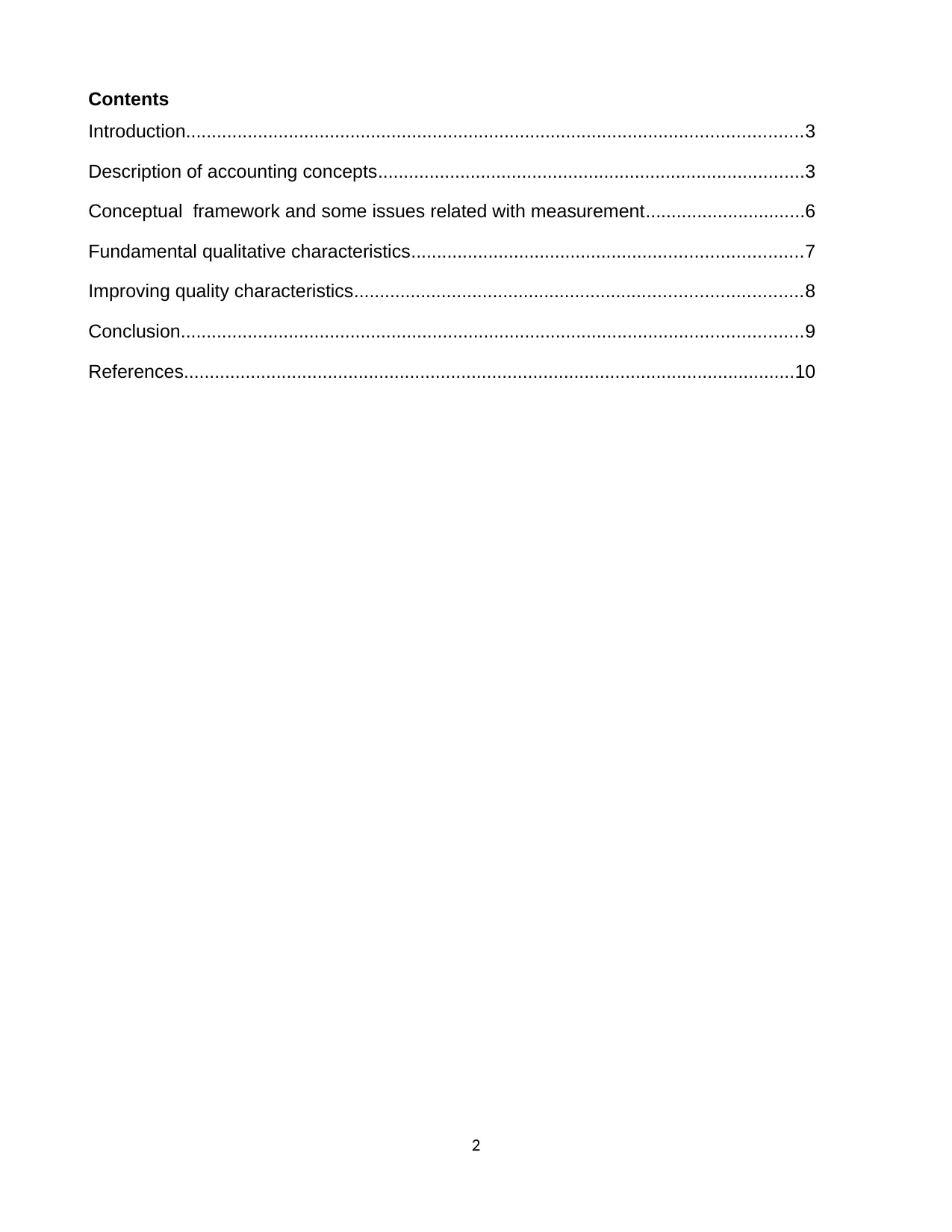
Contents
Introduction........................................................................................................................3
Description of accounting concepts...................................................................................3
Conceptual framework and some issues related with measurement...............................6
Fundamental qualitative characteristics............................................................................7
Improving quality characteristics.......................................................................................8
Conclusion.........................................................................................................................9
References.......................................................................................................................10
2
Introduction........................................................................................................................3
Description of accounting concepts...................................................................................3
Conceptual framework and some issues related with measurement...............................6
Fundamental qualitative characteristics............................................................................7
Improving quality characteristics.......................................................................................8
Conclusion.........................................................................................................................9
References.......................................................................................................................10
2
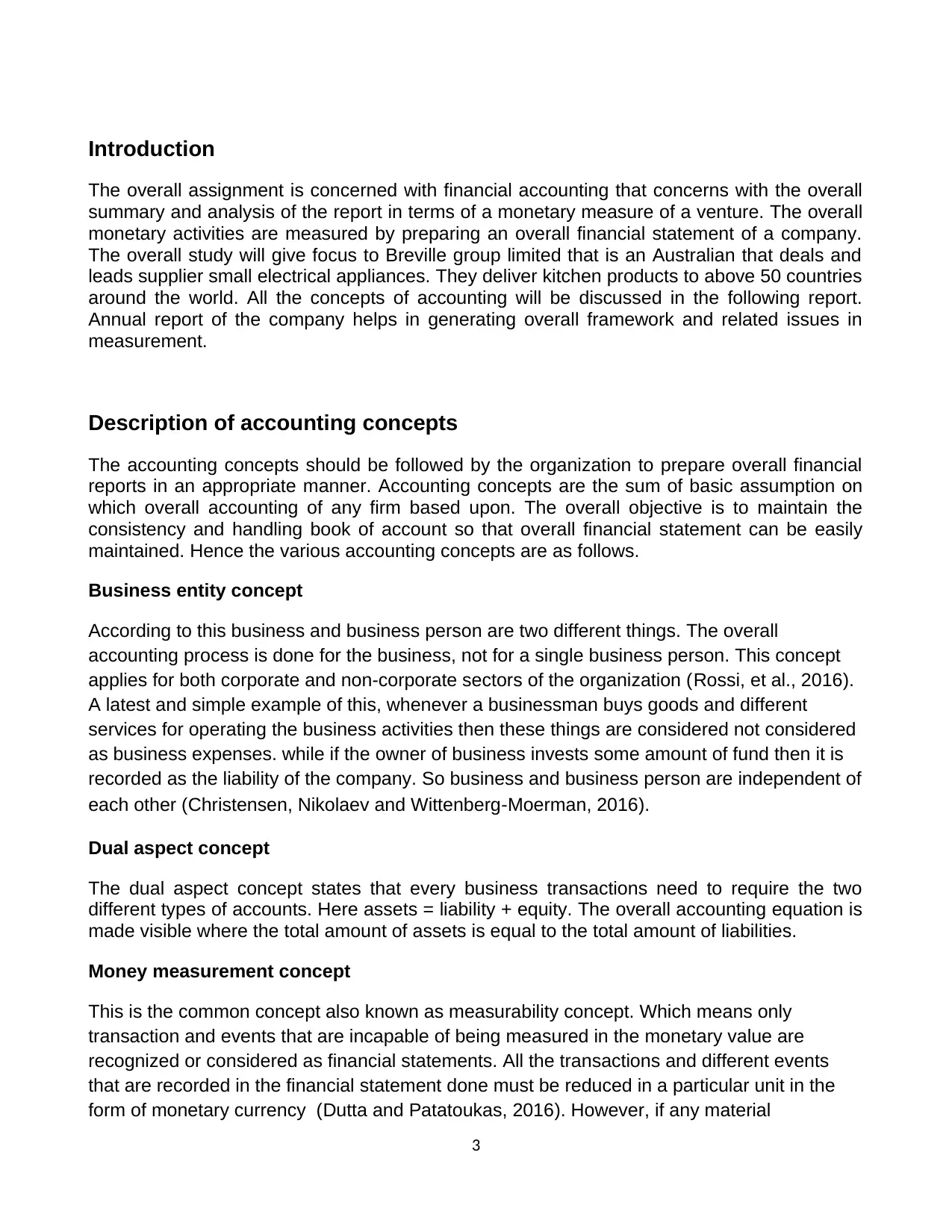
Introduction
The overall assignment is concerned with financial accounting that concerns with the overall
summary and analysis of the report in terms of a monetary measure of a venture. The overall
monetary activities are measured by preparing an overall financial statement of a company.
The overall study will give focus to Breville group limited that is an Australian that deals and
leads supplier small electrical appliances. They deliver kitchen products to above 50 countries
around the world. All the concepts of accounting will be discussed in the following report.
Annual report of the company helps in generating overall framework and related issues in
measurement.
Description of accounting concepts
The accounting concepts should be followed by the organization to prepare overall financial
reports in an appropriate manner. Accounting concepts are the sum of basic assumption on
which overall accounting of any firm based upon. The overall objective is to maintain the
consistency and handling book of account so that overall financial statement can be easily
maintained. Hence the various accounting concepts are as follows.
Business entity concept
According to this business and business person are two different things. The overall
accounting process is done for the business, not for a single business person. This concept
applies for both corporate and non-corporate sectors of the organization (Rossi, et al., 2016).
A latest and simple example of this, whenever a businessman buys goods and different
services for operating the business activities then these things are considered not considered
as business expenses. while if the owner of business invests some amount of fund then it is
recorded as the liability of the company. So business and business person are independent of
each other (Christensen, Nikolaev and Wittenberg‐Moerman, 2016).
Dual aspect concept
The dual aspect concept states that every business transactions need to require the two
different types of accounts. Here assets = liability + equity. The overall accounting equation is
made visible where the total amount of assets is equal to the total amount of liabilities.
Money measurement concept
This is the common concept also known as measurability concept. Which means only
transaction and events that are incapable of being measured in the monetary value are
recognized or considered as financial statements. All the transactions and different events
that are recorded in the financial statement done must be reduced in a particular unit in the
form of monetary currency (Dutta and Patatoukas, 2016). However, if any material
3
The overall assignment is concerned with financial accounting that concerns with the overall
summary and analysis of the report in terms of a monetary measure of a venture. The overall
monetary activities are measured by preparing an overall financial statement of a company.
The overall study will give focus to Breville group limited that is an Australian that deals and
leads supplier small electrical appliances. They deliver kitchen products to above 50 countries
around the world. All the concepts of accounting will be discussed in the following report.
Annual report of the company helps in generating overall framework and related issues in
measurement.
Description of accounting concepts
The accounting concepts should be followed by the organization to prepare overall financial
reports in an appropriate manner. Accounting concepts are the sum of basic assumption on
which overall accounting of any firm based upon. The overall objective is to maintain the
consistency and handling book of account so that overall financial statement can be easily
maintained. Hence the various accounting concepts are as follows.
Business entity concept
According to this business and business person are two different things. The overall
accounting process is done for the business, not for a single business person. This concept
applies for both corporate and non-corporate sectors of the organization (Rossi, et al., 2016).
A latest and simple example of this, whenever a businessman buys goods and different
services for operating the business activities then these things are considered not considered
as business expenses. while if the owner of business invests some amount of fund then it is
recorded as the liability of the company. So business and business person are independent of
each other (Christensen, Nikolaev and Wittenberg‐Moerman, 2016).
Dual aspect concept
The dual aspect concept states that every business transactions need to require the two
different types of accounts. Here assets = liability + equity. The overall accounting equation is
made visible where the total amount of assets is equal to the total amount of liabilities.
Money measurement concept
This is the common concept also known as measurability concept. Which means only
transaction and events that are incapable of being measured in the monetary value are
recognized or considered as financial statements. All the transactions and different events
that are recorded in the financial statement done must be reduced in a particular unit in the
form of monetary currency (Dutta and Patatoukas, 2016). However, if any material
3
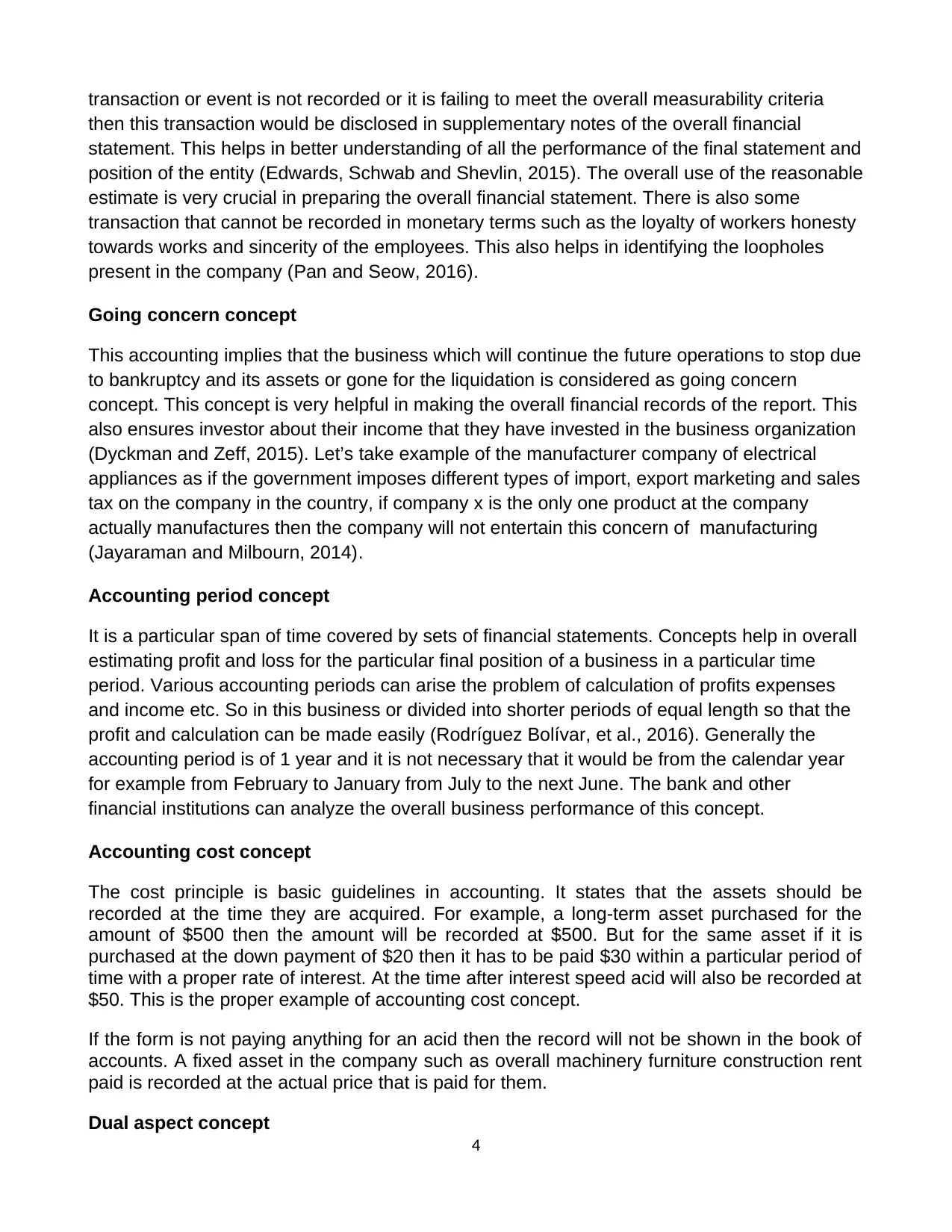
transaction or event is not recorded or it is failing to meet the overall measurability criteria
then this transaction would be disclosed in supplementary notes of the overall financial
statement. This helps in better understanding of all the performance of the final statement and
position of the entity (Edwards, Schwab and Shevlin, 2015). The overall use of the reasonable
estimate is very crucial in preparing the overall financial statement. There is also some
transaction that cannot be recorded in monetary terms such as the loyalty of workers honesty
towards works and sincerity of the employees. This also helps in identifying the loopholes
present in the company (Pan and Seow, 2016).
Going concern concept
This accounting implies that the business which will continue the future operations to stop due
to bankruptcy and its assets or gone for the liquidation is considered as going concern
concept. This concept is very helpful in making the overall financial records of the report. This
also ensures investor about their income that they have invested in the business organization
(Dyckman and Zeff, 2015). Let’s take example of the manufacturer company of electrical
appliances as if the government imposes different types of import, export marketing and sales
tax on the company in the country, if company x is the only one product at the company
actually manufactures then the company will not entertain this concern of manufacturing
(Jayaraman and Milbourn, 2014).
Accounting period concept
It is a particular span of time covered by sets of financial statements. Concepts help in overall
estimating profit and loss for the particular final position of a business in a particular time
period. Various accounting periods can arise the problem of calculation of profits expenses
and income etc. So in this business or divided into shorter periods of equal length so that the
profit and calculation can be made easily (Rodríguez Bolívar, et al., 2016). Generally the
accounting period is of 1 year and it is not necessary that it would be from the calendar year
for example from February to January from July to the next June. The bank and other
financial institutions can analyze the overall business performance of this concept.
Accounting cost concept
The cost principle is basic guidelines in accounting. It states that the assets should be
recorded at the time they are acquired. For example, a long-term asset purchased for the
amount of $500 then the amount will be recorded at $500. But for the same asset if it is
purchased at the down payment of $20 then it has to be paid $30 within a particular period of
time with a proper rate of interest. At the time after interest speed acid will also be recorded at
$50. This is the proper example of accounting cost concept.
If the form is not paying anything for an acid then the record will not be shown in the book of
accounts. A fixed asset in the company such as overall machinery furniture construction rent
paid is recorded at the actual price that is paid for them.
Dual aspect concept
4
then this transaction would be disclosed in supplementary notes of the overall financial
statement. This helps in better understanding of all the performance of the final statement and
position of the entity (Edwards, Schwab and Shevlin, 2015). The overall use of the reasonable
estimate is very crucial in preparing the overall financial statement. There is also some
transaction that cannot be recorded in monetary terms such as the loyalty of workers honesty
towards works and sincerity of the employees. This also helps in identifying the loopholes
present in the company (Pan and Seow, 2016).
Going concern concept
This accounting implies that the business which will continue the future operations to stop due
to bankruptcy and its assets or gone for the liquidation is considered as going concern
concept. This concept is very helpful in making the overall financial records of the report. This
also ensures investor about their income that they have invested in the business organization
(Dyckman and Zeff, 2015). Let’s take example of the manufacturer company of electrical
appliances as if the government imposes different types of import, export marketing and sales
tax on the company in the country, if company x is the only one product at the company
actually manufactures then the company will not entertain this concern of manufacturing
(Jayaraman and Milbourn, 2014).
Accounting period concept
It is a particular span of time covered by sets of financial statements. Concepts help in overall
estimating profit and loss for the particular final position of a business in a particular time
period. Various accounting periods can arise the problem of calculation of profits expenses
and income etc. So in this business or divided into shorter periods of equal length so that the
profit and calculation can be made easily (Rodríguez Bolívar, et al., 2016). Generally the
accounting period is of 1 year and it is not necessary that it would be from the calendar year
for example from February to January from July to the next June. The bank and other
financial institutions can analyze the overall business performance of this concept.
Accounting cost concept
The cost principle is basic guidelines in accounting. It states that the assets should be
recorded at the time they are acquired. For example, a long-term asset purchased for the
amount of $500 then the amount will be recorded at $500. But for the same asset if it is
purchased at the down payment of $20 then it has to be paid $30 within a particular period of
time with a proper rate of interest. At the time after interest speed acid will also be recorded at
$50. This is the proper example of accounting cost concept.
If the form is not paying anything for an acid then the record will not be shown in the book of
accounts. A fixed asset in the company such as overall machinery furniture construction rent
paid is recorded at the actual price that is paid for them.
Dual aspect concept
4
Secure Best Marks with AI Grader
Need help grading? Try our AI Grader for instant feedback on your assignments.
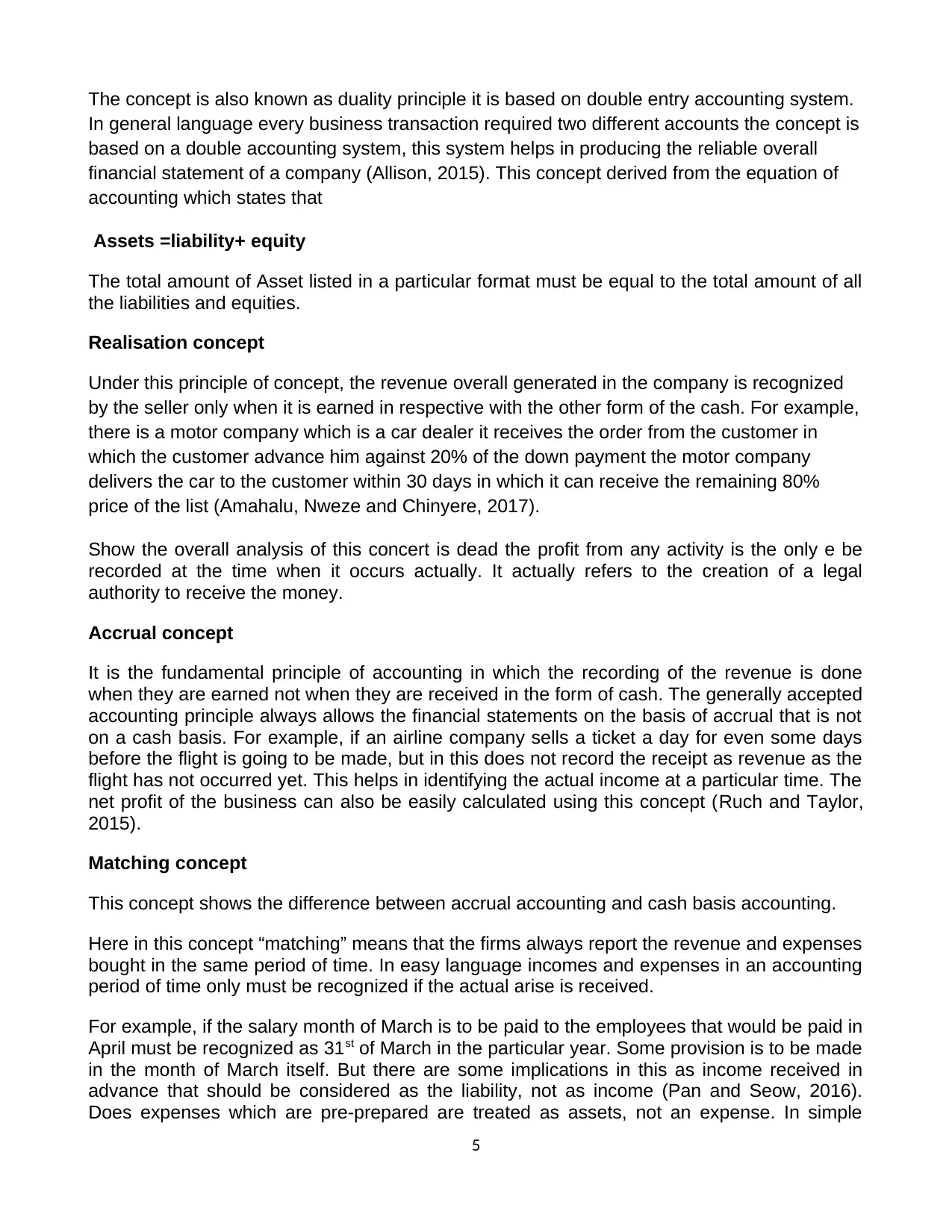
The concept is also known as duality principle it is based on double entry accounting system.
In general language every business transaction required two different accounts the concept is
based on a double accounting system, this system helps in producing the reliable overall
financial statement of a company (Allison, 2015). This concept derived from the equation of
accounting which states that
Assets =liability+ equity
The total amount of Asset listed in a particular format must be equal to the total amount of all
the liabilities and equities.
Realisation concept
Under this principle of concept, the revenue overall generated in the company is recognized
by the seller only when it is earned in respective with the other form of the cash. For example,
there is a motor company which is a car dealer it receives the order from the customer in
which the customer advance him against 20% of the down payment the motor company
delivers the car to the customer within 30 days in which it can receive the remaining 80%
price of the list (Amahalu, Nweze and Chinyere, 2017).
Show the overall analysis of this concert is dead the profit from any activity is the only e be
recorded at the time when it occurs actually. It actually refers to the creation of a legal
authority to receive the money.
Accrual concept
It is the fundamental principle of accounting in which the recording of the revenue is done
when they are earned not when they are received in the form of cash. The generally accepted
accounting principle always allows the financial statements on the basis of accrual that is not
on a cash basis. For example, if an airline company sells a ticket a day for even some days
before the flight is going to be made, but in this does not record the receipt as revenue as the
flight has not occurred yet. This helps in identifying the actual income at a particular time. The
net profit of the business can also be easily calculated using this concept (Ruch and Taylor,
2015).
Matching concept
This concept shows the difference between accrual accounting and cash basis accounting.
Here in this concept “matching” means that the firms always report the revenue and expenses
bought in the same period of time. In easy language incomes and expenses in an accounting
period of time only must be recognized if the actual arise is received.
For example, if the salary month of March is to be paid to the employees that would be paid in
April must be recognized as 31st of March in the particular year. Some provision is to be made
in the month of March itself. But there are some implications in this as income received in
advance that should be considered as the liability, not as income (Pan and Seow, 2016).
Does expenses which are pre-prepared are treated as assets, not an expense. In simple
5
In general language every business transaction required two different accounts the concept is
based on a double accounting system, this system helps in producing the reliable overall
financial statement of a company (Allison, 2015). This concept derived from the equation of
accounting which states that
Assets =liability+ equity
The total amount of Asset listed in a particular format must be equal to the total amount of all
the liabilities and equities.
Realisation concept
Under this principle of concept, the revenue overall generated in the company is recognized
by the seller only when it is earned in respective with the other form of the cash. For example,
there is a motor company which is a car dealer it receives the order from the customer in
which the customer advance him against 20% of the down payment the motor company
delivers the car to the customer within 30 days in which it can receive the remaining 80%
price of the list (Amahalu, Nweze and Chinyere, 2017).
Show the overall analysis of this concert is dead the profit from any activity is the only e be
recorded at the time when it occurs actually. It actually refers to the creation of a legal
authority to receive the money.
Accrual concept
It is the fundamental principle of accounting in which the recording of the revenue is done
when they are earned not when they are received in the form of cash. The generally accepted
accounting principle always allows the financial statements on the basis of accrual that is not
on a cash basis. For example, if an airline company sells a ticket a day for even some days
before the flight is going to be made, but in this does not record the receipt as revenue as the
flight has not occurred yet. This helps in identifying the actual income at a particular time. The
net profit of the business can also be easily calculated using this concept (Ruch and Taylor,
2015).
Matching concept
This concept shows the difference between accrual accounting and cash basis accounting.
Here in this concept “matching” means that the firms always report the revenue and expenses
bought in the same period of time. In easy language incomes and expenses in an accounting
period of time only must be recognized if the actual arise is received.
For example, if the salary month of March is to be paid to the employees that would be paid in
April must be recognized as 31st of March in the particular year. Some provision is to be made
in the month of March itself. But there are some implications in this as income received in
advance that should be considered as the liability, not as income (Pan and Seow, 2016).
Does expenses which are pre-prepared are treated as assets, not an expense. In simple
5
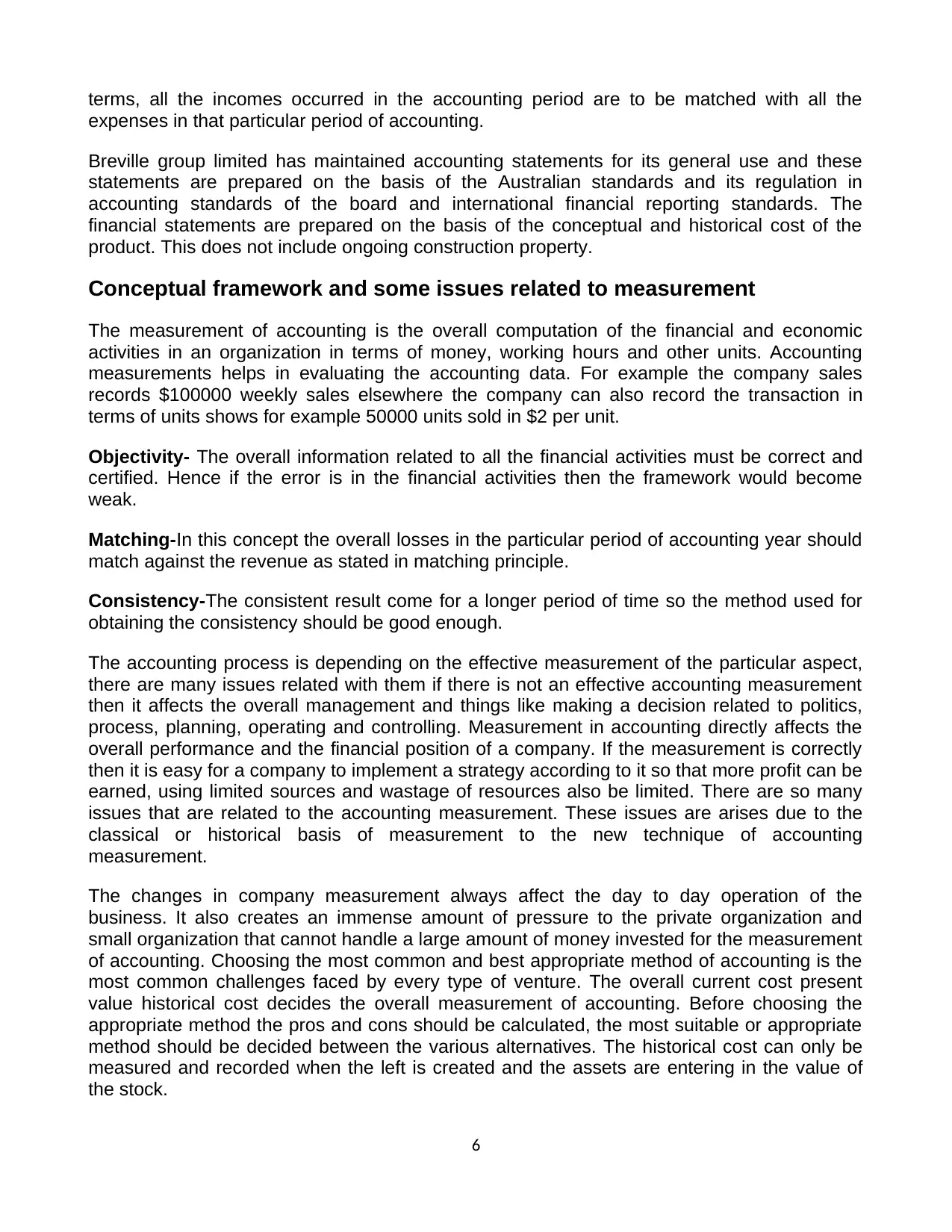
terms, all the incomes occurred in the accounting period are to be matched with all the
expenses in that particular period of accounting.
Breville group limited has maintained accounting statements for its general use and these
statements are prepared on the basis of the Australian standards and its regulation in
accounting standards of the board and international financial reporting standards. The
financial statements are prepared on the basis of the conceptual and historical cost of the
product. This does not include ongoing construction property.
Conceptual framework and some issues related to measurement
The measurement of accounting is the overall computation of the financial and economic
activities in an organization in terms of money, working hours and other units. Accounting
measurements helps in evaluating the accounting data. For example the company sales
records $100000 weekly sales elsewhere the company can also record the transaction in
terms of units shows for example 50000 units sold in $2 per unit.
Objectivity- The overall information related to all the financial activities must be correct and
certified. Hence if the error is in the financial activities then the framework would become
weak.
Matching-In this concept the overall losses in the particular period of accounting year should
match against the revenue as stated in matching principle.
Consistency-The consistent result come for a longer period of time so the method used for
obtaining the consistency should be good enough.
The accounting process is depending on the effective measurement of the particular aspect,
there are many issues related with them if there is not an effective accounting measurement
then it affects the overall management and things like making a decision related to politics,
process, planning, operating and controlling. Measurement in accounting directly affects the
overall performance and the financial position of a company. If the measurement is correctly
then it is easy for a company to implement a strategy according to it so that more profit can be
earned, using limited sources and wastage of resources also be limited. There are so many
issues that are related to the accounting measurement. These issues are arises due to the
classical or historical basis of measurement to the new technique of accounting
measurement.
The changes in company measurement always affect the day to day operation of the
business. It also creates an immense amount of pressure to the private organization and
small organization that cannot handle a large amount of money invested for the measurement
of accounting. Choosing the most common and best appropriate method of accounting is the
most common challenges faced by every type of venture. The overall current cost present
value historical cost decides the overall measurement of accounting. Before choosing the
appropriate method the pros and cons should be calculated, the most suitable or appropriate
method should be decided between the various alternatives. The historical cost can only be
measured and recorded when the left is created and the assets are entering in the value of
the stock.
6
expenses in that particular period of accounting.
Breville group limited has maintained accounting statements for its general use and these
statements are prepared on the basis of the Australian standards and its regulation in
accounting standards of the board and international financial reporting standards. The
financial statements are prepared on the basis of the conceptual and historical cost of the
product. This does not include ongoing construction property.
Conceptual framework and some issues related to measurement
The measurement of accounting is the overall computation of the financial and economic
activities in an organization in terms of money, working hours and other units. Accounting
measurements helps in evaluating the accounting data. For example the company sales
records $100000 weekly sales elsewhere the company can also record the transaction in
terms of units shows for example 50000 units sold in $2 per unit.
Objectivity- The overall information related to all the financial activities must be correct and
certified. Hence if the error is in the financial activities then the framework would become
weak.
Matching-In this concept the overall losses in the particular period of accounting year should
match against the revenue as stated in matching principle.
Consistency-The consistent result come for a longer period of time so the method used for
obtaining the consistency should be good enough.
The accounting process is depending on the effective measurement of the particular aspect,
there are many issues related with them if there is not an effective accounting measurement
then it affects the overall management and things like making a decision related to politics,
process, planning, operating and controlling. Measurement in accounting directly affects the
overall performance and the financial position of a company. If the measurement is correctly
then it is easy for a company to implement a strategy according to it so that more profit can be
earned, using limited sources and wastage of resources also be limited. There are so many
issues that are related to the accounting measurement. These issues are arises due to the
classical or historical basis of measurement to the new technique of accounting
measurement.
The changes in company measurement always affect the day to day operation of the
business. It also creates an immense amount of pressure to the private organization and
small organization that cannot handle a large amount of money invested for the measurement
of accounting. Choosing the most common and best appropriate method of accounting is the
most common challenges faced by every type of venture. The overall current cost present
value historical cost decides the overall measurement of accounting. Before choosing the
appropriate method the pros and cons should be calculated, the most suitable or appropriate
method should be decided between the various alternatives. The historical cost can only be
measured and recorded when the left is created and the assets are entering in the value of
the stock.
6
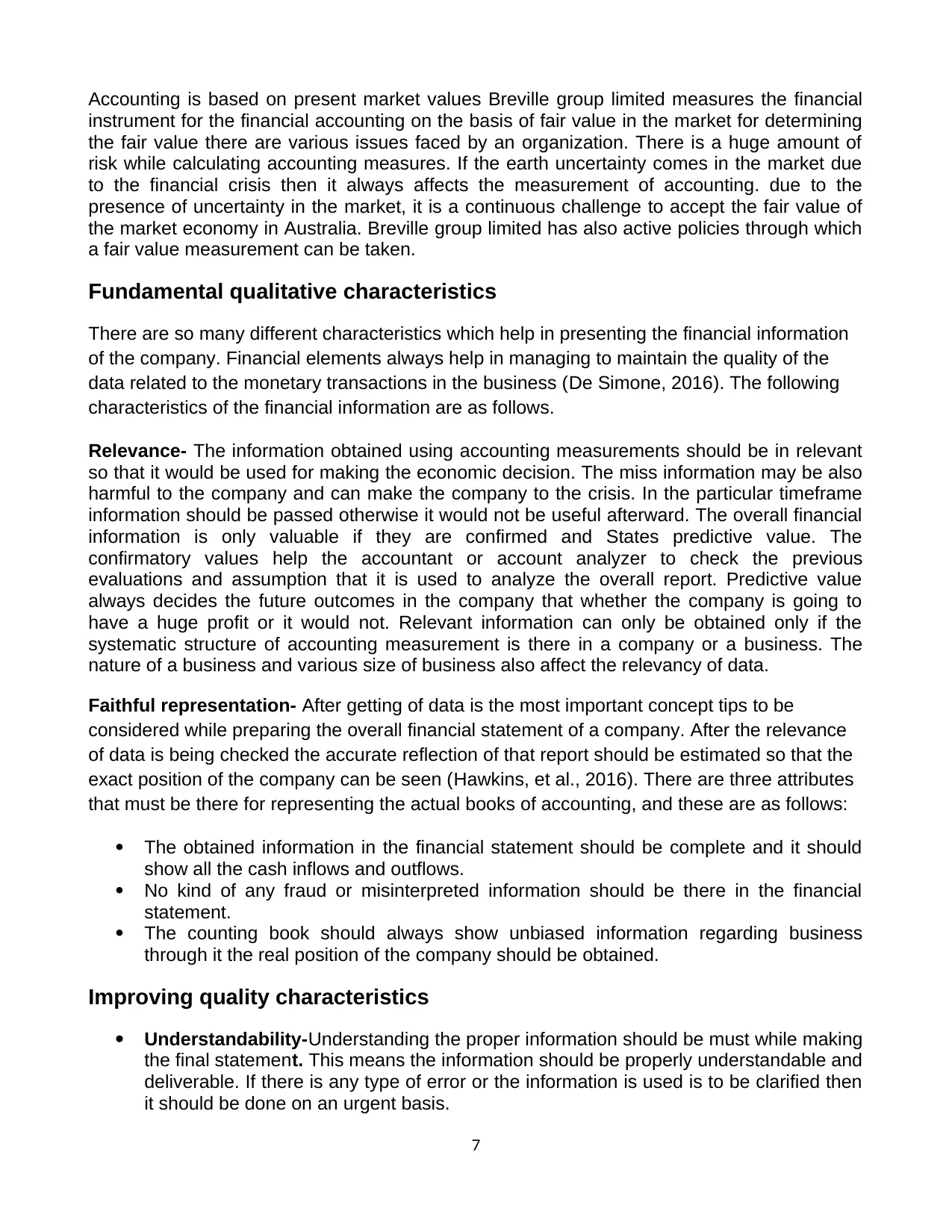
Accounting is based on present market values Breville group limited measures the financial
instrument for the financial accounting on the basis of fair value in the market for determining
the fair value there are various issues faced by an organization. There is a huge amount of
risk while calculating accounting measures. If the earth uncertainty comes in the market due
to the financial crisis then it always affects the measurement of accounting. due to the
presence of uncertainty in the market, it is a continuous challenge to accept the fair value of
the market economy in Australia. Breville group limited has also active policies through which
a fair value measurement can be taken.
Fundamental qualitative characteristics
There are so many different characteristics which help in presenting the financial information
of the company. Financial elements always help in managing to maintain the quality of the
data related to the monetary transactions in the business (De Simone, 2016). The following
characteristics of the financial information are as follows.
Relevance- The information obtained using accounting measurements should be in relevant
so that it would be used for making the economic decision. The miss information may be also
harmful to the company and can make the company to the crisis. In the particular timeframe
information should be passed otherwise it would not be useful afterward. The overall financial
information is only valuable if they are confirmed and States predictive value. The
confirmatory values help the accountant or account analyzer to check the previous
evaluations and assumption that it is used to analyze the overall report. Predictive value
always decides the future outcomes in the company that whether the company is going to
have a huge profit or it would not. Relevant information can only be obtained only if the
systematic structure of accounting measurement is there in a company or a business. The
nature of a business and various size of business also affect the relevancy of data.
Faithful representation- After getting of data is the most important concept tips to be
considered while preparing the overall financial statement of a company. After the relevance
of data is being checked the accurate reflection of that report should be estimated so that the
exact position of the company can be seen (Hawkins, et al., 2016). There are three attributes
that must be there for representing the actual books of accounting, and these are as follows:
The obtained information in the financial statement should be complete and it should
show all the cash inflows and outflows.
No kind of any fraud or misinterpreted information should be there in the financial
statement.
The counting book should always show unbiased information regarding business
through it the real position of the company should be obtained.
Improving quality characteristics
Understandability-Understanding the proper information should be must while making
the final statement. This means the information should be properly understandable and
deliverable. If there is any type of error or the information is used is to be clarified then
it should be done on an urgent basis.
7
instrument for the financial accounting on the basis of fair value in the market for determining
the fair value there are various issues faced by an organization. There is a huge amount of
risk while calculating accounting measures. If the earth uncertainty comes in the market due
to the financial crisis then it always affects the measurement of accounting. due to the
presence of uncertainty in the market, it is a continuous challenge to accept the fair value of
the market economy in Australia. Breville group limited has also active policies through which
a fair value measurement can be taken.
Fundamental qualitative characteristics
There are so many different characteristics which help in presenting the financial information
of the company. Financial elements always help in managing to maintain the quality of the
data related to the monetary transactions in the business (De Simone, 2016). The following
characteristics of the financial information are as follows.
Relevance- The information obtained using accounting measurements should be in relevant
so that it would be used for making the economic decision. The miss information may be also
harmful to the company and can make the company to the crisis. In the particular timeframe
information should be passed otherwise it would not be useful afterward. The overall financial
information is only valuable if they are confirmed and States predictive value. The
confirmatory values help the accountant or account analyzer to check the previous
evaluations and assumption that it is used to analyze the overall report. Predictive value
always decides the future outcomes in the company that whether the company is going to
have a huge profit or it would not. Relevant information can only be obtained only if the
systematic structure of accounting measurement is there in a company or a business. The
nature of a business and various size of business also affect the relevancy of data.
Faithful representation- After getting of data is the most important concept tips to be
considered while preparing the overall financial statement of a company. After the relevance
of data is being checked the accurate reflection of that report should be estimated so that the
exact position of the company can be seen (Hawkins, et al., 2016). There are three attributes
that must be there for representing the actual books of accounting, and these are as follows:
The obtained information in the financial statement should be complete and it should
show all the cash inflows and outflows.
No kind of any fraud or misinterpreted information should be there in the financial
statement.
The counting book should always show unbiased information regarding business
through it the real position of the company should be obtained.
Improving quality characteristics
Understandability-Understanding the proper information should be must while making
the final statement. This means the information should be properly understandable and
deliverable. If there is any type of error or the information is used is to be clarified then
it should be done on an urgent basis.
7
Paraphrase This Document
Need a fresh take? Get an instant paraphrase of this document with our AI Paraphraser
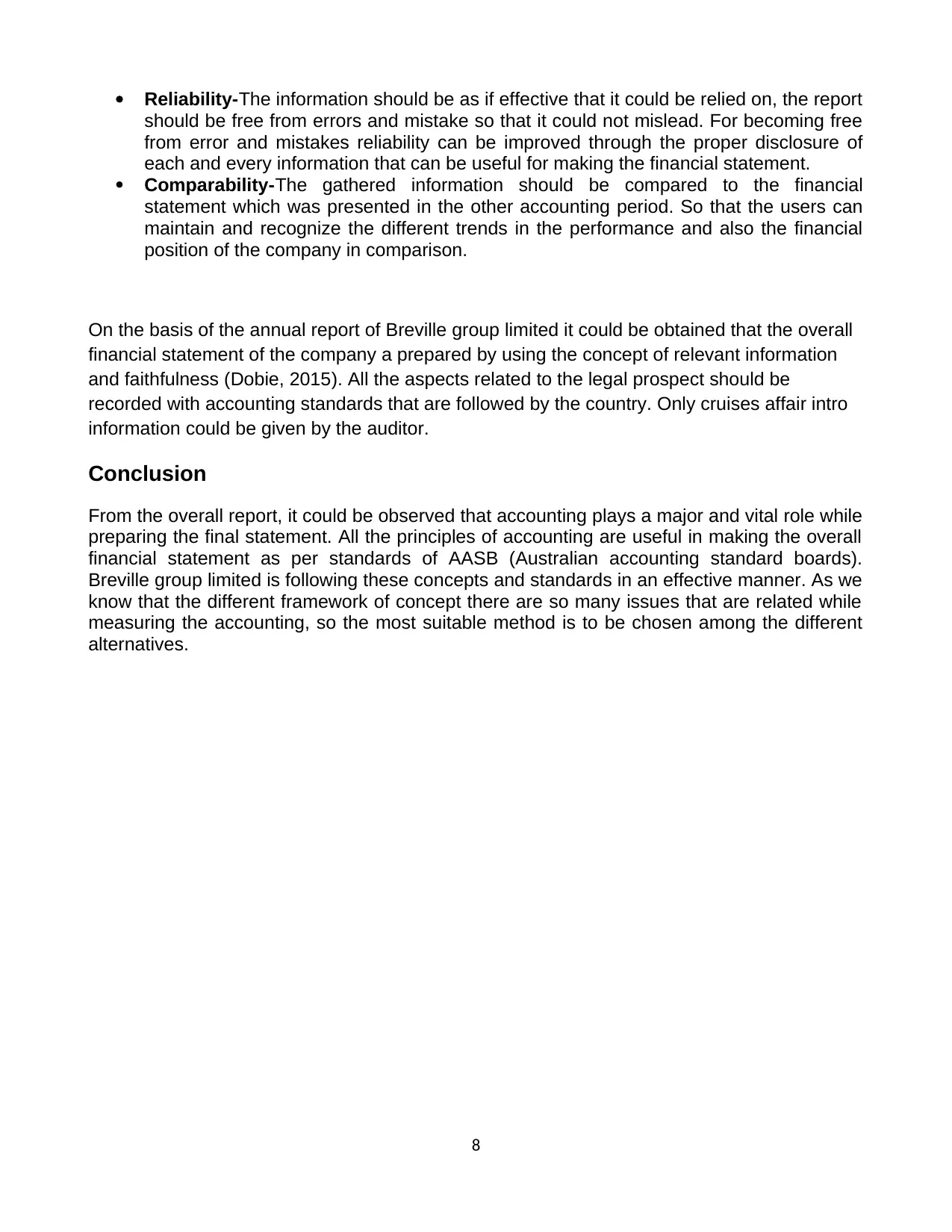
Reliability-The information should be as if effective that it could be relied on, the report
should be free from errors and mistake so that it could not mislead. For becoming free
from error and mistakes reliability can be improved through the proper disclosure of
each and every information that can be useful for making the financial statement.
Comparability-The gathered information should be compared to the financial
statement which was presented in the other accounting period. So that the users can
maintain and recognize the different trends in the performance and also the financial
position of the company in comparison.
On the basis of the annual report of Breville group limited it could be obtained that the overall
financial statement of the company a prepared by using the concept of relevant information
and faithfulness (Dobie, 2015). All the aspects related to the legal prospect should be
recorded with accounting standards that are followed by the country. Only cruises affair intro
information could be given by the auditor.
Conclusion
From the overall report, it could be observed that accounting plays a major and vital role while
preparing the final statement. All the principles of accounting are useful in making the overall
financial statement as per standards of AASB (Australian accounting standard boards).
Breville group limited is following these concepts and standards in an effective manner. As we
know that the different framework of concept there are so many issues that are related while
measuring the accounting, so the most suitable method is to be chosen among the different
alternatives.
8
should be free from errors and mistake so that it could not mislead. For becoming free
from error and mistakes reliability can be improved through the proper disclosure of
each and every information that can be useful for making the financial statement.
Comparability-The gathered information should be compared to the financial
statement which was presented in the other accounting period. So that the users can
maintain and recognize the different trends in the performance and also the financial
position of the company in comparison.
On the basis of the annual report of Breville group limited it could be obtained that the overall
financial statement of the company a prepared by using the concept of relevant information
and faithfulness (Dobie, 2015). All the aspects related to the legal prospect should be
recorded with accounting standards that are followed by the country. Only cruises affair intro
information could be given by the auditor.
Conclusion
From the overall report, it could be observed that accounting plays a major and vital role while
preparing the final statement. All the principles of accounting are useful in making the overall
financial statement as per standards of AASB (Australian accounting standard boards).
Breville group limited is following these concepts and standards in an effective manner. As we
know that the different framework of concept there are so many issues that are related while
measuring the accounting, so the most suitable method is to be chosen among the different
alternatives.
8

9
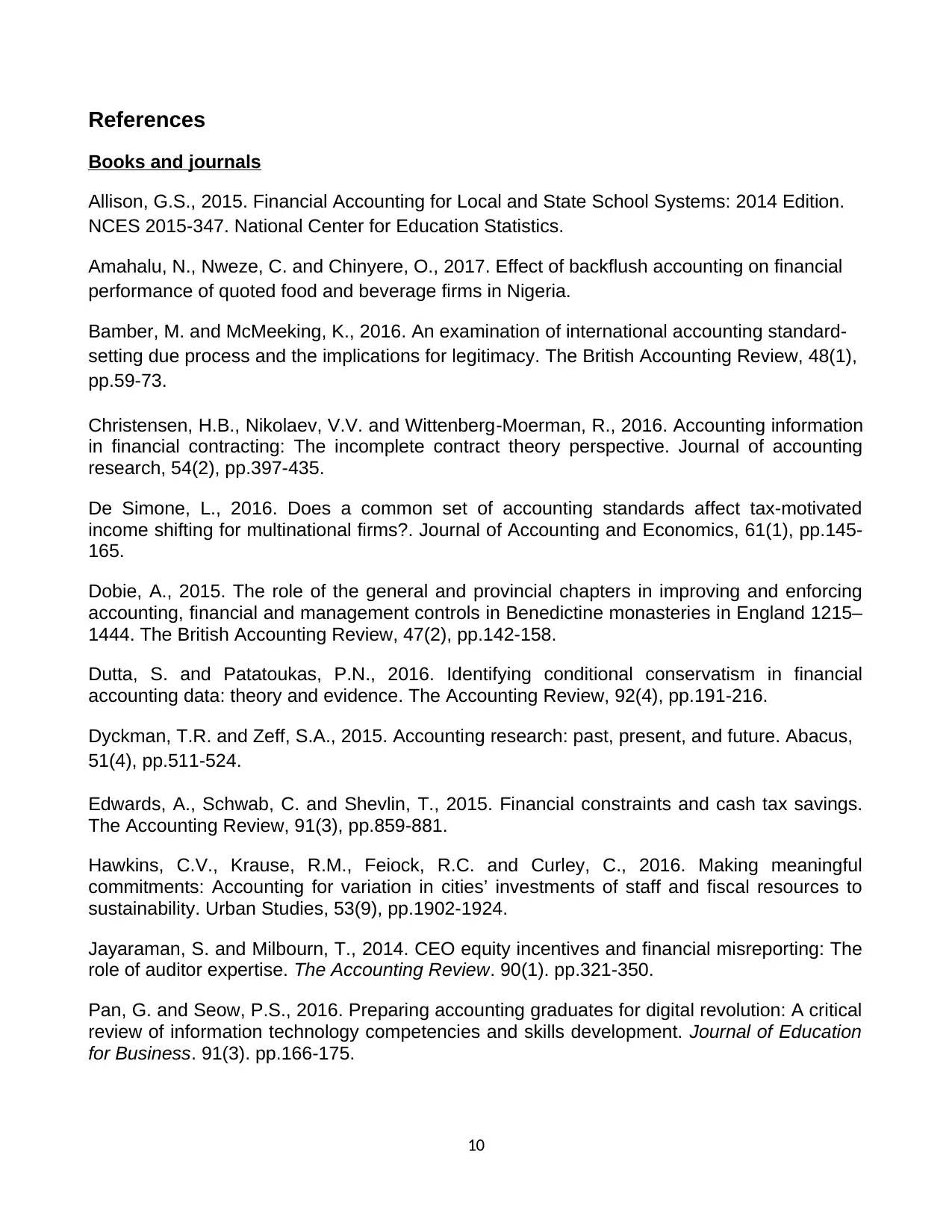
References
Books and journals
Allison, G.S., 2015. Financial Accounting for Local and State School Systems: 2014 Edition.
NCES 2015-347. National Center for Education Statistics.
Amahalu, N., Nweze, C. and Chinyere, O., 2017. Effect of backflush accounting on financial
performance of quoted food and beverage firms in Nigeria.
Bamber, M. and McMeeking, K., 2016. An examination of international accounting standard-
setting due process and the implications for legitimacy. The British Accounting Review, 48(1),
pp.59-73.
Christensen, H.B., Nikolaev, V.V. and Wittenberg‐Moerman, R., 2016. Accounting information
in financial contracting: The incomplete contract theory perspective. Journal of accounting
research, 54(2), pp.397-435.
De Simone, L., 2016. Does a common set of accounting standards affect tax-motivated
income shifting for multinational firms?. Journal of Accounting and Economics, 61(1), pp.145-
165.
Dobie, A., 2015. The role of the general and provincial chapters in improving and enforcing
accounting, financial and management controls in Benedictine monasteries in England 1215–
1444. The British Accounting Review, 47(2), pp.142-158.
Dutta, S. and Patatoukas, P.N., 2016. Identifying conditional conservatism in financial
accounting data: theory and evidence. The Accounting Review, 92(4), pp.191-216.
Dyckman, T.R. and Zeff, S.A., 2015. Accounting research: past, present, and future. Abacus,
51(4), pp.511-524.
Edwards, A., Schwab, C. and Shevlin, T., 2015. Financial constraints and cash tax savings.
The Accounting Review, 91(3), pp.859-881.
Hawkins, C.V., Krause, R.M., Feiock, R.C. and Curley, C., 2016. Making meaningful
commitments: Accounting for variation in cities’ investments of staff and fiscal resources to
sustainability. Urban Studies, 53(9), pp.1902-1924.
Jayaraman, S. and Milbourn, T., 2014. CEO equity incentives and financial misreporting: The
role of auditor expertise. The Accounting Review. 90(1). pp.321-350.
Pan, G. and Seow, P.S., 2016. Preparing accounting graduates for digital revolution: A critical
review of information technology competencies and skills development. Journal of Education
for Business. 91(3). pp.166-175.
10
Books and journals
Allison, G.S., 2015. Financial Accounting for Local and State School Systems: 2014 Edition.
NCES 2015-347. National Center for Education Statistics.
Amahalu, N., Nweze, C. and Chinyere, O., 2017. Effect of backflush accounting on financial
performance of quoted food and beverage firms in Nigeria.
Bamber, M. and McMeeking, K., 2016. An examination of international accounting standard-
setting due process and the implications for legitimacy. The British Accounting Review, 48(1),
pp.59-73.
Christensen, H.B., Nikolaev, V.V. and Wittenberg‐Moerman, R., 2016. Accounting information
in financial contracting: The incomplete contract theory perspective. Journal of accounting
research, 54(2), pp.397-435.
De Simone, L., 2016. Does a common set of accounting standards affect tax-motivated
income shifting for multinational firms?. Journal of Accounting and Economics, 61(1), pp.145-
165.
Dobie, A., 2015. The role of the general and provincial chapters in improving and enforcing
accounting, financial and management controls in Benedictine monasteries in England 1215–
1444. The British Accounting Review, 47(2), pp.142-158.
Dutta, S. and Patatoukas, P.N., 2016. Identifying conditional conservatism in financial
accounting data: theory and evidence. The Accounting Review, 92(4), pp.191-216.
Dyckman, T.R. and Zeff, S.A., 2015. Accounting research: past, present, and future. Abacus,
51(4), pp.511-524.
Edwards, A., Schwab, C. and Shevlin, T., 2015. Financial constraints and cash tax savings.
The Accounting Review, 91(3), pp.859-881.
Hawkins, C.V., Krause, R.M., Feiock, R.C. and Curley, C., 2016. Making meaningful
commitments: Accounting for variation in cities’ investments of staff and fiscal resources to
sustainability. Urban Studies, 53(9), pp.1902-1924.
Jayaraman, S. and Milbourn, T., 2014. CEO equity incentives and financial misreporting: The
role of auditor expertise. The Accounting Review. 90(1). pp.321-350.
Pan, G. and Seow, P.S., 2016. Preparing accounting graduates for digital revolution: A critical
review of information technology competencies and skills development. Journal of Education
for Business. 91(3). pp.166-175.
10
Secure Best Marks with AI Grader
Need help grading? Try our AI Grader for instant feedback on your assignments.
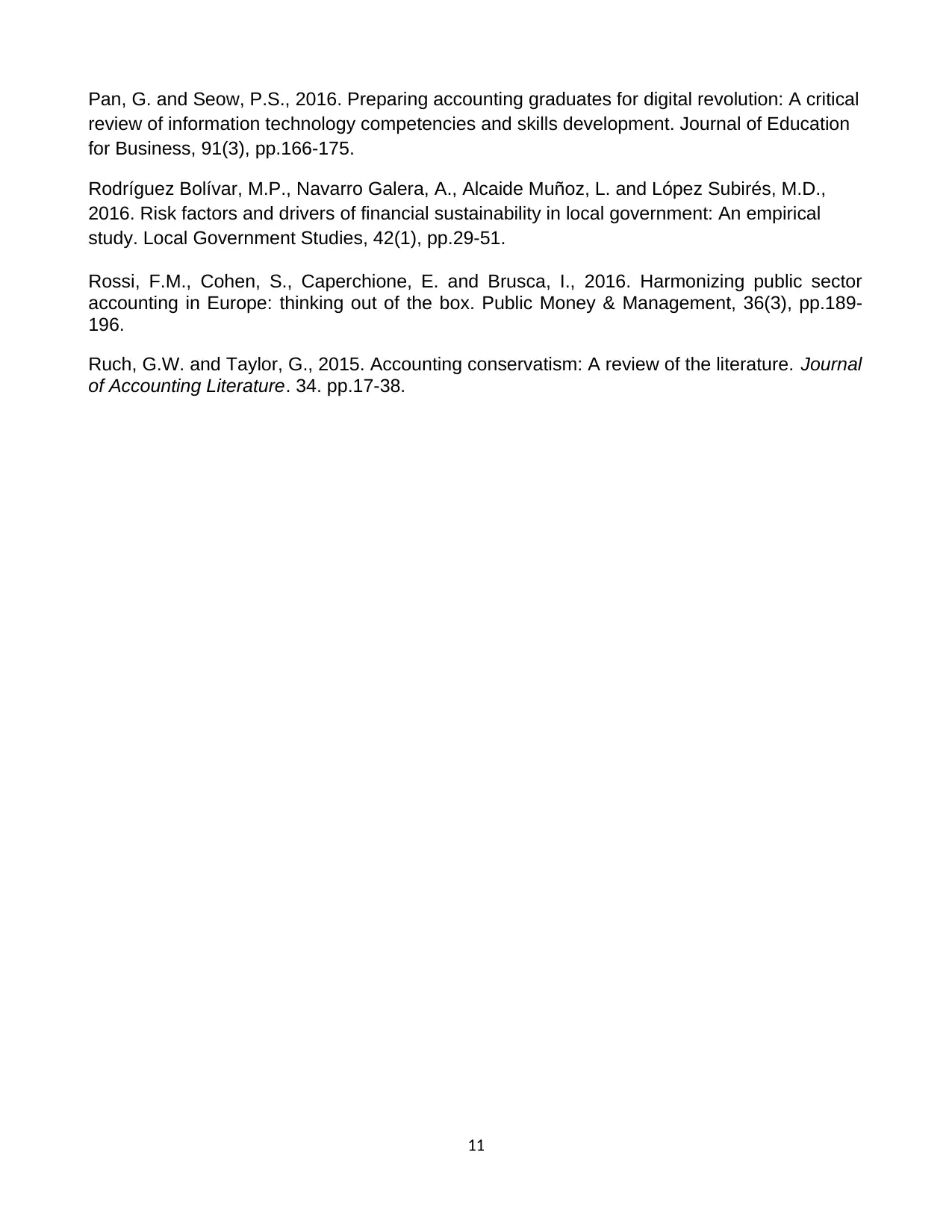
Pan, G. and Seow, P.S., 2016. Preparing accounting graduates for digital revolution: A critical
review of information technology competencies and skills development. Journal of Education
for Business, 91(3), pp.166-175.
Rodríguez Bolívar, M.P., Navarro Galera, A., Alcaide Muñoz, L. and López Subirés, M.D.,
2016. Risk factors and drivers of financial sustainability in local government: An empirical
study. Local Government Studies, 42(1), pp.29-51.
Rossi, F.M., Cohen, S., Caperchione, E. and Brusca, I., 2016. Harmonizing public sector
accounting in Europe: thinking out of the box. Public Money & Management, 36(3), pp.189-
196.
Ruch, G.W. and Taylor, G., 2015. Accounting conservatism: A review of the literature. Journal
of Accounting Literature. 34. pp.17-38.
11
review of information technology competencies and skills development. Journal of Education
for Business, 91(3), pp.166-175.
Rodríguez Bolívar, M.P., Navarro Galera, A., Alcaide Muñoz, L. and López Subirés, M.D.,
2016. Risk factors and drivers of financial sustainability in local government: An empirical
study. Local Government Studies, 42(1), pp.29-51.
Rossi, F.M., Cohen, S., Caperchione, E. and Brusca, I., 2016. Harmonizing public sector
accounting in Europe: thinking out of the box. Public Money & Management, 36(3), pp.189-
196.
Ruch, G.W. and Taylor, G., 2015. Accounting conservatism: A review of the literature. Journal
of Accounting Literature. 34. pp.17-38.
11
1 out of 11
Related Documents
Your All-in-One AI-Powered Toolkit for Academic Success.
+13062052269
info@desklib.com
Available 24*7 on WhatsApp / Email
![[object Object]](/_next/static/media/star-bottom.7253800d.svg)
Unlock your academic potential
© 2024 | Zucol Services PVT LTD | All rights reserved.




